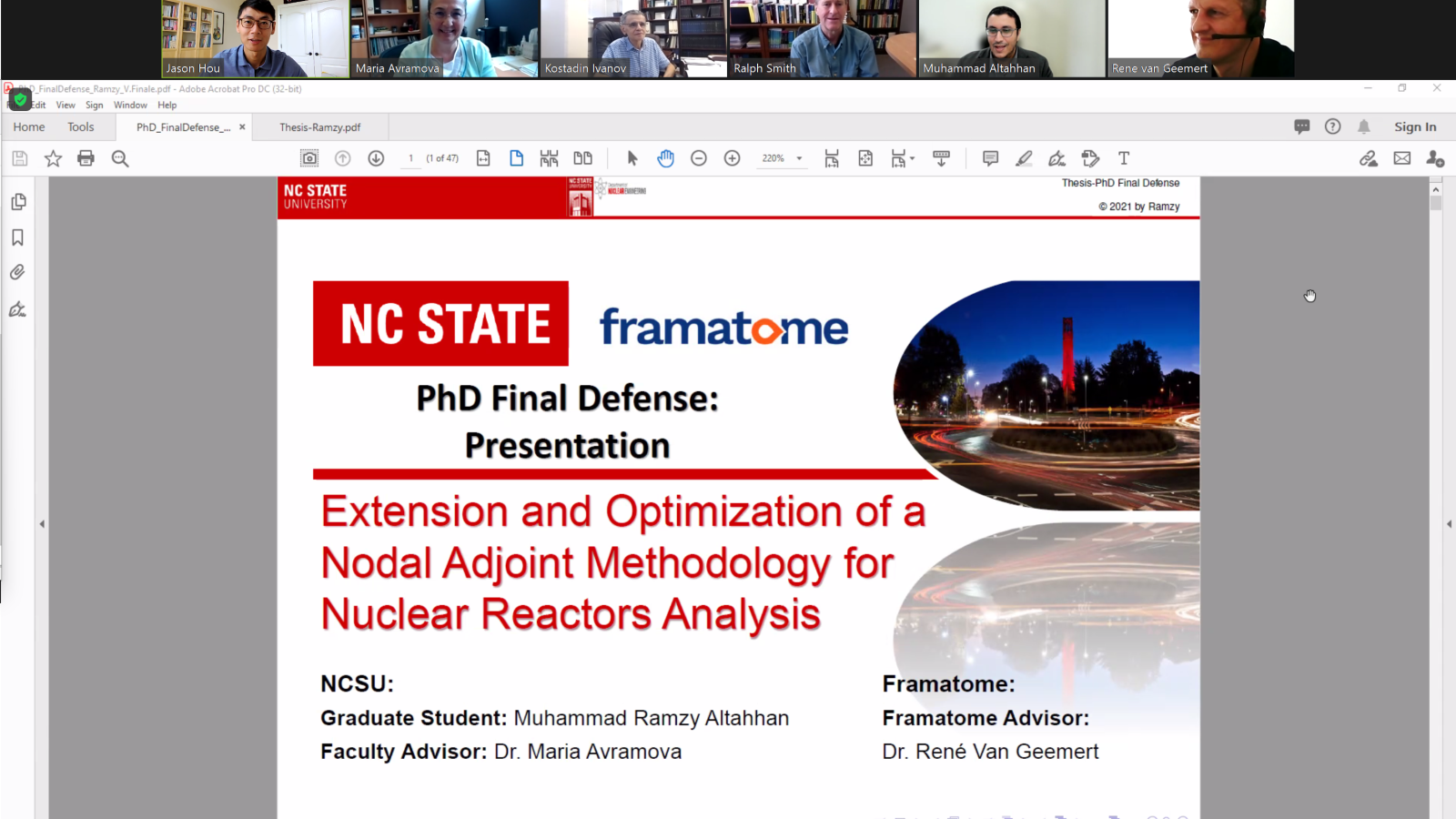On October 8, 2021, Muhammad Ramzy Altahhan successfully defended his PhD dissertation, Extension and Optimization of a Nodal Adjoint Methodology for Nuclear Reactors Analysis. The PhD committee consisted of his co-advisors, Maria Avramova and René van Geemert, and members, Jason Hou, Kostadin Ivanov, and Ralph Smith.
Abstract
ALTAHHAN, MUHAMMAD RAMZY. Extension and Optimization of a Nodal Adjoint Methodology for Nuclear Reactors Analysis. (Under the direction of Drs. Maria Avramova & René van Geemert).
Many current mathematical and numerical tools (e.g., machine learning, optimization, and perturbation analysis, to name a few) can use the adjoint or the dual function in their core computations. The adjoint function has become then a building block of modern numerical analysis, and acquiring a good adjoint solution opens new research possibilities as is indeed shown in this thesis. A higher-order nodal mathematical adjoint conjugate to the NEM-M2B2 nodal diffusion forward model is developed and introduced in this thesis. Verification of the developed model is presented through applications in perturbation analysis and the IAEA-3D benchmark including adjusted forms of it. Extending and optimizing a low-order nodal mathematical adjoint capability found in the ARTEMIS industrial code is the thesis main objective.
Nodal mathematical adjoint derivation is equivocal in the literature, and its physical interpretation is not agreed upon; if not totally avoided by many. But through preconditioning of the base NEM-M2B2 nodal diffusion forward model and by applying Lagrange’s adjoint theory technique, we have obtained a nodal mathematical adjoint that can have a physical interpretation associated with it as a Lagrangian multiplier. The nodal mathematical adjoint is then developed for several Response of Interests (RoIs) that can lead to a homogeneous and inhomogeneous adjoint system of equations. The adjoint solution verification is done through the analysis of the effects from perturbations in the absorption and the scattering cross-sections on a RoI. The applications investigated include axially and radially traveling perturbations along the reactor’s core. Several locations for the traveling perturbations are chosen to represent important locations in the core.
A methodology to simulate large perturbations, using the developed and verified VIPER-SIF and the VIPER-LF algorithms, is introduced. The methodology depends on the incremental perturbation idea in which the targeted perturbation is incrementally divided into smaller steps. An individual step simulation time takes around 10-4 seconds, even without compilers’ code optimization flags, amounting to a tremendous computational time saving when compared to the forward model computations that can take on the order of 1 second. The ability of simulating ±100% perturbations with high accuracy and rapidly for the studied RoIs, using the linear prediction formulas, and for different types of perturbations, is revealed. Such capability extends the regime of applicability of the linear perturbation prediction formula and adds to the literature in terms of methods to simulate large perturbations.
During several parts of the thesis, comparison between the low-order and the higher-order adjoint models is conducted. Both the nominal IAEA-3D benchmark, and a more challenging version of it, are used to compare both models. The forward model is set to the NEM-M2B2 nodal diffusion equation for both adjoints during the comparison. The higher-order adjoint model developed show consistent results in comparison to its lower-order sibling as explained and showed in the thesis, suggesting the preference of using the developed higher-order model for adjoint computations.
The value of this thesis comes from introducing the developed higher-order nodal mathematical adjoint model, and using it in adjoint perturbation analysis including the associated applications. Verification steps and methodologies, that can be applied to any adjoint code in development, are also described in detail. Furthermore, comparison against an industrial-grade low-order nodal adjoint model is shown. Additionally, several code snippets and numerical algorithms, that include algorithms enabling large perturbations analysis using the simple linear perturbation formula, are also developed in hope to be of benefit to the interested community. Finally, future work that is worthy of investigation is also presented alongside recommendations, and the experience attained during the PhD journey is also presented in several applied parts of the thesis.

